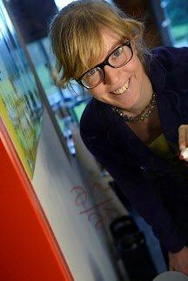Fluid flow in drying drops
Promotion date: April 19.
Promotor: Prof.dr. Detlef Lohse
Assistantpromotor: Dr.ir. Jacco H. Snoeijer
| When a suspension drop evaporates, it leaves behind a drying stain. Examples of these drying stains encountered in daily life are coffee or tea stains on a table top, mineral rings on glassware that comes out of the dishwasher, or the salt deposits on the streets in winter. Drying stains are also present in industrial processes, for example in the printing and coating industry, where the non-uniform drying of drops can be a problem. Pattern formation by evaporation of colloidal suspension drops can however also be used as a tool to manufacture tiny structures on a scale where direct manipulation is not possible. In order to either prevent ring-stain formation or control the type of stains that are formed, one needs to understand the basic physics of evaporating drops and their internal fluid flow. In this thesis the focus is on the fundamentals of drop evaporation, evaporation-driven flow in drying drops, and the subsequent particle transport and deposition. We used a simple model system: a macroscopic sessile water drop that evaporates under atmospheric conditions and contains spherical polystyrene particles. By evaporation of these colloidal suspension drops remarkable, highly-ordered drying patterns were obtained. |
Was your thesis project fundamental in nature, or were applications also relevant here?
Drop evaporation was studied on its fundamentals. After discovering the ordered particle organization in drying stains formed by evaporating drops, we were able to come up with a promising theoretical approach. Here the particle ordering was explained as a function of both particle transport velocity during evaporation and particle sizes.
Experimental outcomes served as an inspiration. These outcomes suggested a spatially bounded transition of order and disorder within drying stains; the orderly structures being located more to the frontier areas of the stains. A scientific question arose from that straightaway, in fact two: what are the driving forces behind these phenomena and - even more intriguing – are we able to control these forces?
These kind of questions are highly actual in crystalline structures used in chip manufacturing. Also useful applications are thinkable in ordered 3D structures, for example in designing new ways to control the permeability of membranes.
Did you manage to come up with nice results?
Various topics were published in scientific magazines. The coffee stain work was published in Physical Review Letters, and the study about 3D ordered structures in PNAS: Proceedings of the National Academy of Sciences. Also I contributed to: the Journal of Fluid Mechanics, Physical Review E and Physics of Fluids.
These are remarkable results. What was the key to this success?
We possessed the right mix of talent and expertise within our project team, I believe. As a theorist I collaborated intensely with my colleague Álvaro Gomez Marín, who is a very skilled experimentalist and is also a great expert on this field of research. He was able to translate my theoretical findings in designing clever experiments. By collaborating we complemented each other’s fortes and speeded up the process by adding extra expertise.
Also the input of professor Detlef Lohse and Jacco Snoeijer was decisive at times. As a team we formed an ideal mix. Our meetings were fruitful, leading to a great productivity.
As a researcher I developed personally in these four years. First of all I gained a lot of knowledge and expertise in fluid mechanics, since I graduated as a biomedical engineer. In the PhD period I also learned to plan a vast and complex project like this which I had never done before. Furthermore I learned to incorporate various theoretical techniques like: scaling analysis, self-similarity and lubrication theory. With some of these techniques I was already somewhat familiar; in my master work, fluid mechanics was also of prime importance since I worked on blood flow patterns. So, this is a constant throughout my work thus far, one could say.
What are your future plans?
I am going to work on a shared project by the Physics of Fluids group and ASML, co-financed by FOM. Besides attending the work on projects of three PhD students, I am also going to work as a researcher on different themes.
To me this is an exciting project as it combines working on research and on education. In my PhD project I enjoyed giving lectures and tutorial classes, and also I enjoyed accompanying students. Transfer of knowledge and to help pupils come to understanding, is a very rewarding thing to do. Also it challenged me to look at my field of research in a new and broader scope.
What, in your opinion, is important for Mesa+ to stay successful in future?
During my thesis research I didn’t spend much time in the Mesa+ cleanroom. Nor did I use the Mesa+ labs or other shared facilities, as I am a theorist. However, my experimental colleague did make extensive use of the Mesa facilities.
I imagine it a good thing to collaborate more on micro fluidic subjects in a multidisciplinary way. Bringing in expertise from groups led by professor Han Gardeniers and professor Leon Lefferts - as we have done during my project - can lead to new projects when ideas are given the opportunity to merge.

